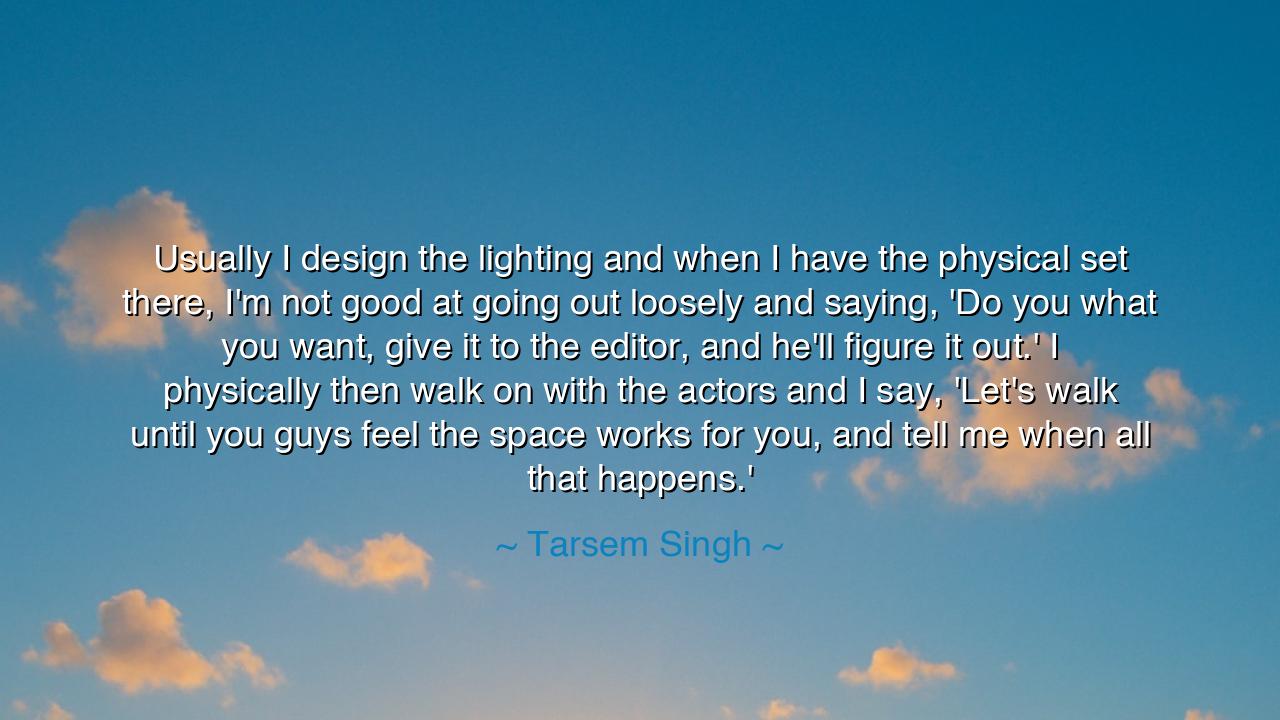
Usually I design the lighting and when I have the physical set
Usually I design the lighting and when I have the physical set there, I'm not good at going out loosely and saying, 'Do you what you want, give it to the editor, and he'll figure it out.' I physically then walk on with the actors and I say, 'Let's walk until you guys feel the space works for you, and tell me when all that happens.'






In the words of Tarsem Singh, the visionary filmmaker of dreamscapes and living paintings, there lies a sacred truth about creation and control, about the dance between structure and freedom. When he says, “Usually I design the lighting and when I have the physical set there, I'm not good at going out loosely and saying, 'Do what you want…’” he speaks not as a mere director of images, but as a craftsman of worlds. His words reveal the ancient struggle of the artist — the desire to shape perfection, to breathe order into chaos, and yet to remain humble before the unpredictable spirit of collaboration. This is the balance between discipline and spontaneity, between the light that reveals and the shadow that inspires.
From the earliest days of art, masters have known this balance. The sculptor Michelangelo, when asked how he carved David, said he merely freed the figure from the marble that already contained it. He, too, was both designer and servant — controlling the chisel’s every strike, yet listening for the voice of the stone. So it is with Tarsem Singh, who designs lighting — not as decoration, but as divine architecture — and yet allows the actors to walk, to breathe, to find their truth within the space he has made. He is both the sun that sets the stage and the gardener who lets the flowers bloom in their own way.
In his quote, Tarsem reveals a profound respect for space — that invisible companion to every work of art. He does not command his actors to move; he invites them to discover. “Let’s walk until you feel the space works for you,” he says — a statement that glows with the humility of wisdom. It is not the mark of a dictator of images, but of a seer, one who understands that every performance is born of harmony between body, light, and place. The great storytellers of the past — from the architects of temples to the playwrights of Athens — understood that space shapes emotion. To step into a well-designed space is to step into a rhythm, a silence, a meaning that words cannot name.
Think of the Japanese tea master Sen no Rikyū, who designed every tearoom as a universe of mindfulness. Each object, each shadow, each slant of light had purpose. Yet when the guests entered, he would say nothing, letting them find their own peace within his creation. Tarsem’s method is the same: he builds with care, then surrenders with trust. The artist, if wise, must learn when to shape — and when to release. For art is not complete until it is felt, and no human heart can be forced to feel.
There is, in his process, a lesson for all who create — not only filmmakers and artists, but teachers, leaders, builders of dreams. It is this: true mastery does not mean control over others, but harmony with them. The leader who designs every beam of light yet listens to the footsteps of his companions is far greater than the one who commands from a distance. Tarsem walks with his actors; he seeks their truth as much as his own. In that act of walking together, creation becomes communion.
Yet, hear also the courage in his confession: “I’m not good at going out loosely.” He admits his nature, not as weakness, but as fidelity to his craft. There is honor in devotion, in knowing that great art demands precision and intention. To design the light is to sculpt emotion. To set the frame is to define the soul’s boundary. The ancients, too, understood this — for even the most spontaneous dance must happen upon a stage built with care. Freedom needs form; otherwise, it dissolves into chaos.
So, my child of the future, learn this sacred paradox: structure is not the enemy of freedom, but its womb. Create with intention, yet leave space for discovery. Build your temples with your own hands, but invite others to pray in their own way. When you lead, do not merely command — walk among your people, and listen until the rhythm of the space feels right. Like Tarsem Singh, design your light, but let others find their way within its glow.
For in the end, the greatest art — and the greatest life — is not the one dictated by certainty, but the one illuminated by collaboration, guided by light, and alive with shared movement. To walk together, until it feels right — that is not only filmmaking. That is the eternal art of being human.






AAdministratorAdministrator
Welcome, honored guests. Please leave a comment, we will respond soon